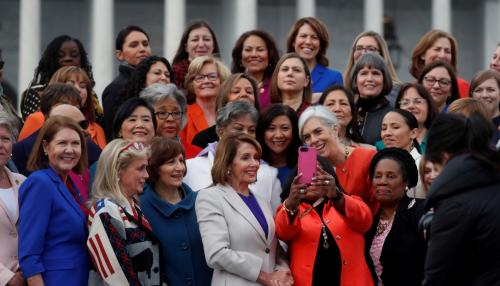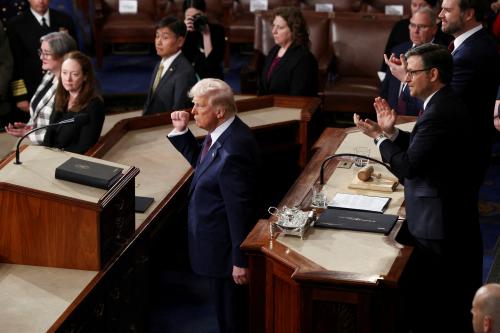This op-ed was originally published on Real Clear Policy on April 19, 2021.
Good news: the U.S. jumped from 53rd to 30th on the World Economic Forum’s global ranking of gender equality, flanked by Denmark and Holland. The rise was largely the result of progress on the political front, especially President Biden’s appointment of women to his Cabinet. But progress in Congress remains painfully slow. It is time for quotas in order to move the needle here.
Overall, the Forum’s Global Gender Gap report made for less upbeat reading, especially in terms of the prediction that the world will not reach gender equality until the year 2156, a date that has been pushed back by 36 years as a result of a single year of the pandemic. For what it is worth, this is likely an overly pessimistic view. The WEF prediction is based on a simple straight-line extrapolation of the trend over the last fifteen years into the future. But this is a weak prediction method. It is hard to imagine that developments over the last few years provide a good forecast of likely trends in the early 22nd century. So, although the prediction is what grabs the headlines, it should be treated as, at best, a “stylized fact.”
The much greater value of the WEF report is in the painstaking collection and aggregation of details on a whole range of indices of gender equality from around the world, from education and wages to health and politics.
Equality in politics: mixed news globally, but U.S. on the rise
Across the globe, the news on gender equality in politics was disappointing, with some ground lost since the last report in 2020. This was also the domain where there is most variation between nations, with some countries, such as Iceland, quite close to equality, while others, such as Japan, lag way behind. WEF also reports dramatic falls in female ministerial representation in a number of countries in the last two years, including India (from 23% to 9%), Indonesia (from 24% to 17%), and Poland (from 27% to 5%).
But for the U.S., easily the biggest gain was on the political front. Last year my essay for the Brookings series on the 19th Amendment was titled “100 years on, politics is where the U.S. lags most on gender equality.” In 2021, this is much less true.
Three variables factor into the WEF score for political equality: years with a woman as head of state, as well as female representation in national legislatures, and in the cabinet. The U.S. obviously remains at a flat zero on the first of these. There has been a further increase in the representation of women in Congress, from 24% to 27%. But the big change has been in ministerial representation.
As I wrote last year: “The fastest way to improve the U.S. ranking would be to for either President Trump or President Biden to follow Trudeau’s lead and appoint a balanced cabinet. Overnight, the global standing of the U.S. in terms of gender equality would be dramatically improved.” President Biden has delivered on this front, with the U.S almost reaching gender parity in cabinet as a result of him successfully fulfilling his promise to appoint a cabinet that “looks like America.”
In my essay last year, I compared the U.S. to our immediate neighbors, Canada and Mexico — both of whom were way ahead in terms of gender equality in politics. Now things look much more even. The chart below shows the overall score for political empowerment, as well as two of the variables that contribute to the score (ratio of women in parliament and ratio of women in ministerial positions), as compared for 2020 and 2021. As shown, in 2021, the ratio of women in the U.S. in ministerial positions is much closer to parity at .859, than it was in 2020, at .277.
 Source: World Economic Forum’s Global Gender Gap Report 2021. Available from https://www.weforum.org/reports/global-gender-gap-report-2021.
Source: World Economic Forum’s Global Gender Gap Report 2021. Available from https://www.weforum.org/reports/global-gender-gap-report-2021.
But the U.S. should hardly be content with 30th place overall in the world, or with 37th place for equality in politics. To say that a woman president is overdue would be an understatement; witness the joy over managing at least the Vice Presidency for Kamala Harris. An ongoing commitment to a balanced Cabinet is also of course vitally important, as the recent WEF results demonstrate.
More gender parity in Congress: Time for quotas
That leaves Congress, where the U.S. is still well behind 59 other countries in terms of female representation, including many Western European countries, as well as Bangladesh, Namibia, Mexico, El Salvador and Senegal. Also ranked ahead of the U.S. for gender equality in politics in this year’s report was the United Arab Emirates, which leapt up the political equality table from 112th to 24th in the world following an increase in female representation from 23% in the 2019 report to gender parity at 50% today — a doubling in female parliamentary representation in just two years.
What lies behind UAE’s dramatic improvement? The short answer is: an order from the top. In 2019, His Highness Sheikh Khalifa bin Zayed Al Nahyan, issued Presidential Resolution No. (1) ordering equal representation of Emirati women in the Federal National Council.
While UAE is an unusual case, other nations have achieved similar increases, on a slightly slower timetable, using a range of other approaches — including quotas. Since 2014, the Mexican constitution, for example, has required gender parity among candidates from all political parties for positions in the federal Chamber of Deputies and Senate.
In my previous essay, I argued in favor of quotas, which clearly improve gender equality with no loss in the quality of legislators (if anything, the opposite). “Quota laws work,” says Sofia Alessandra Ramirez of the Council on Foreign Relations. In fact, more than half the countries in the world now use some form of quota system to increase female representation.
The problem in the U.S is that even if legislation could be passed, it would almost certainly be struck down as unconstitutional by the Supreme Court. Nothing, however, is to stop the major political parties from adopting such quotas themselves — like parties in many other countries. It is reasonable to think that the Democrats might consider such a policy first.
After all, if President Biden believes it is important to have a Cabinet that looks like America, shouldn’t we want a Congress that looks the same way? Quotas are a blunt tool, to be used with great care — and which hopefully will become unnecessary in the longer term. But when it comes to ensuring greater representativeness in our Representatives in terms of gender, the case for quotas is strong. Then the U.S. might move further up the equality table. Would we settle for being 30th in the world on any other metric?
The Brookings Institution is committed to quality, independence, and impact.
We are supported by a diverse array of funders. In line with our values and policies, each Brookings publication represents the sole views of its author(s).






Commentary
Op-edCongress needs gender parity quotas
April 21, 2021